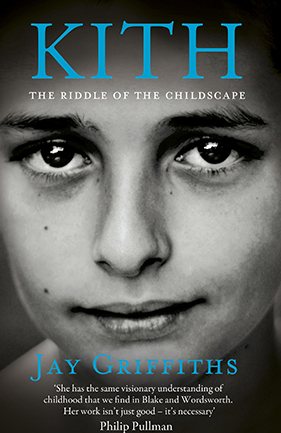A word of advice on reading Jay Griffiths’ Kith, The Riddle of the Childscape – suspend your rational faculties. Surrender to the lyricism. Let nostalgia woo you. Be carried on the wings of your imagination. Allow yourself to spiral into your childhood (either the one you really had or the one about which you fantasise) and go with Griffiths into a secret garden of faerie, forests, daemon and metaphor. Roam free.
Griffiths writes in a Romantic way
 Griffiths’ subject matter is Romanticism. She therefore writes in a Romantic way. If you don’t realise that and start saying: “Hang on a bit, that’s a bit of an outrageous claim isn’t it? Where’s the evidence for that?” you’ll end up getting very irritated indeed, which would be a shame when you could be out in the forest playing.
Griffiths’ subject matter is Romanticism. She therefore writes in a Romantic way. If you don’t realise that and start saying: “Hang on a bit, that’s a bit of an outrageous claim isn’t it? Where’s the evidence for that?” you’ll end up getting very irritated indeed, which would be a shame when you could be out in the forest playing.
Romanticism was the movement that originated in Europe toward the end of the 18th century, partly as a reaction against the industrial revolution. It gave us the poets William Wordsworth, Samuel Taylor Coleridge, John Keats, Mary Wollstonecraft Shelley, Percy Bysshe Shelley, William Blake and John Clare.
Romantics criticised reason
Romantics criticised an over-emphasis on reason, the enlightenment, materialism and the bourgeoise. They celebrated nature, the imagination and the artist and gave us the concepts of genius and faerie.
Griffiths argues that we need a resurgence of the vision of Romanticism to heal our consumerist, urban, health-and-safety-crazy culture which deprives children of animals, nature and the freedom to roam.
Kith means native country
Kith, she says, does not refer to friends and extended family, as most of us understand it in the phrase “kith and kin”. It comes from the Old English cydd, which means native country, one’s home outside the house. Her claim is that in being deprived of nature, children are deprived of their kith and feel an ache for it, a nostalgia, a longing for belonging. “In West Papua, a mountain may be referred to as ‘mother’ to all the children who grow up in her foothills,” she says.
She says: “Romanticism, now, here is necessary as a way of understanding childhood, not as a passing interest in the past but because Romanticism comprehends what is perennially important, beautiful, valuable and good in the human condition, and finds these treasures within us all.”
Romanticism for the twenty-first century
Griffiths is re-imagining Romanticism for the twenty-first century. She is re-creating the childhood vision of Wordsworth, Blake and John Clare in a culture of Play Stations, SATs and Amazon wish-lists.
And she does it well.. She writes of woods and wonder and fairy tales in a way that re-awakens deep longings. I welcome the words “kith” and “childscape” to my vocabulary because thinking of childhood not just as a time but as a place with its own contours and geography within the mind, is a vivid, almost tactile way of understanding it, which helps us to honour our children and treasure our beginnings.
I wish Griffiths wasn’t so silly
I just wish Griffiths wasn’t so silly. At times it seems she would rather stick her tongue out at modern, urban lifestyles than enter into a reasoned discussion about them.
“Why are some many children in Euro-American cultures unhappy?” she asks. (Am I the only person who hadn’t noticed that they were?) “Why does the dominant culture treat young humans in ways which would be illegal if applied to young dogs?” (Whaaaaat?)
She asks us to imagine the outcry if so called ‘public’ houses displayed signs saying ‘No Jews unless Accompanied by a Gentile’ and then says that is the experience of kids. “It’s really ugly.” (If I were to say all the things I think about that statement I wouldn’t have space to write anything else in this review.)
She should have stuck to what she is good at
Griffiths critique of “Euro-American” culture would be more persuasive if she was more accurate. She writes about exuberance, for example, and quotes the nineteenth century author Landmann who claimed exuberance was a trait in children that bordered on abnormality.“Whereas Laudmann asserted that exuberance was a character fault, society now calls it a medical disorder: ADHD (Attention Deficit Hyperactivity Disorder).”
In making out the judgement of our mental health professionals has become so distorted they can’t tell the difference between exuberance and the disturbed inability to pay attention that gets classed as ADHD, she goes too far. That’s a shame because the phenomenon of ADHD and the prescription of Ritalin is indeed a worrying feature of our society that is worthy of examination and debate, but to my mind Griffiths almost blows her credibility on the issue by being ridiculous.
I think Griffiths would have done better if she had stuck to what she is good at – re-kindling a vision of Romanticism – and resisted her critique of the dominant culture, where she needs to be more balanced, accurate and rigorous. She may well say that balance, accuracy and rigour aren’t dominant features in Romanticism, to which I would say: “Fine. Be Romantic. But leave the critique to those who do it well.”
Let yourself be wooed by faerie
I enjoyed Kith when I gave myself permission to skip over its more irritating moments, allow myself to be wooed by faerie and simply ask: “What aspects of the Romantic vision do we need to rediscover in our Churches?”
The themes of Romanticism, says Griffiths, are passion, imagination, heroism, a dislike of social convention, a sense of justice, a sense of quest and chivalry, a desire for integrity and the authentic, a will towards self-determination, a willingness to see the sublime, a concern with the particular and local, a need for freedom, an innate love of nature, intuitive creativity, a sense of inner, epiphanic, spontaneous time, an interest in the daemonic, a belief in faerie, an ability to endow the ordinary with mystery, an anti-mechanistic world-view and a sense of wildness and the transcendent.
I would like a more Romantic church
Yes. I’d like all of those, please. There isn’t one of them that isn’t right at the heart of Christianity (once the concepts of daemon and faerie within the Romantic mind are properly understood).
Now…reading Kith has got me imagining… I wonder how many of the children in our inner-city church have been in a forest…let’s see if we can find a way of spending some time there….
- A version of this review appears in Third Way.
